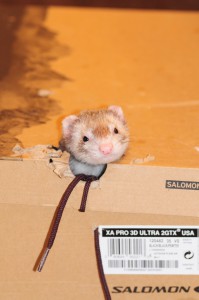In Chapter 3 of my humorous, touching memoir, Something Furry Underfoot, I tell how our first ferret was soon joined by a second, then a third, until we had four crazy, inquisitive ferrets in our house. As with the other pets that came into my house, I knew nothing about ferrets. Here are a few things I learned.
- Ferrets are still illegal in some states, and some local municipalities require permits, so check your local laws and regs before you consider getting a ferret.
- At pet stores near me, I can buy a ferret for somewhere around $150. A good cage, water bottle, food dishes, hammocks, toys, and litter can cost anywhere from $200-$300. Vet visits for basic shots and other preventatives, and continuing to provide good food, treats and bedding can cost several hundred dollars a year. I found ferrets to be more expensive that our cat, Purrkins, and much more expensive than our hamsters, gerbils, guinea pigs and mice.
- A good cage is one that will keep a ferret safe during the approximately 18 hours a day they are usually in cages. A good cage will have very little spacing between shelves OR, if there is a lot of spacing, you’ll need to make the potential fall less than 4 inches with hammocks and old sweatshirts. As I wrote in Chapter 3 of Something Furry Underfoot, our sweet little ferret named Chunky cost $1,200 in vet bills because Chunky fell in his cage and the vets back in the late 1990s weren’t able to immediately diagnosis his broken back. With a lot of help on our part, Chunky recovered, but we hope his story helps people realize the importance of reducing the distance a ferret can fall in a cage.

- Ferrets mostly take to litter boxes, however, they’re not always perfect and they sometimes make messes on the floor. If you can’t deal with an occasional mess, a ferret may not be right for you.
- Ferrets will explore every inch of every room you give them access to. They can open and disappear in bathroom cupboards, they might dig up house plants, they can disappear in the overhangs of kitchen cupboards. It is important to ferret-proof your house, putting safety latches on all cupboards they can’t get access to and sealing any cupboard overhangs.

- Ferrets need to be kept in safe places or supervised at all times if allowed to explore somewhere new. Our ferret, Rocky, got into the underside of our La-Z Boy chair, and since he could get crushed if someone sat down, we had to watch and wait until he came out, then seal up the underside of the chair with duct tape. Ferrets were the most time-intensive pets we owned. And we’ve owned a lot of pets!
- Ferrets can interact with other pets, but keep an eye on any pet bigger than your ferret. We had one dog that was great with the ferrets, another dog that tolerated them, and one cat that we had to watch at all times because he sometimes got rough with the ferrets.

- In my book Something Furry Underfoot, Tip #12 is: Ferrets are curious little thieves that will claim everything as their own. Keep erasers, lipsticks, lip balms, balloons and other similar items out of ferret reach. These non-edible items can cause blockages, which require an emergency trip to the vet.
- Ferrets don’t make much noise, so it is easy to step on them. Owners need to get used to walking with an eye to the floor. That’s true even if you have a bunch of ferrets.

- A ferret can live 6-10 years. During the first few years ferrets are vivacious, explore everything, and can get into trouble. But for the last six to 12 months of their life, most of my ferrets needed help getting around. Chip liked to be pulled around in a shoebox.
The American Ferret Association web site contains great advice about what to feed—and what NOT to feed—your ferret. The site also contains important information about caring for your ferret, including the fact that because ferrets have high metabolism, it is necessary to get them to a vet as soon as there is a change in your ferret’s energy or behavior.
Because ferrets are quick, curious, fragile, and can get in and out of things quickly, they aren’t right for everyone. But if one IS right for you, you’ll be taking in a very energetic, curious pet that will want to play with you and with other ferret pals. If you have a real happy ferret, you’ll get to see a “weasel war dance” which is when they sort of bounce on their little feet and twist around.
Read more about life with ferrets in Chapter 3 of Something Furry Underfoot, available at Amazon.com and Smashwords.com. Or go to Amylpeterson.com and click on My Books. Also, check out my children’s rhyming photo e-book Goodnight, Big Wuzzy about one of our ferret pals.




I don’t have a website so I just put that and all of the stuff it made up but in just wanted to say can u do something on what you need for a new ferret please I rely need to know I’m going to get a ferret and I’m clueless on what to get thanks bye